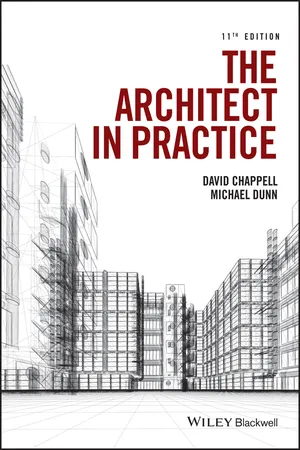
- English
- ePUB (mobile friendly)
- Available on iOS & Android
The Architect in Practice
About this book
Throughout its many editions, The Architect in Practice has remained a leading textbook used in the education of architects. While the content of the book has developed, the message and philosophy has remained constant: to provide students of architecture and young practitioners with a readable guide to the profession, outlining an architect's duties to their client and contractor, the key aspects of running a building contract, and the essentials of management, finance and drawing office procedure.
The eleventh edition follows in that tradition. The text has been brought up to date to ensure it follows the new RIBA Plan of Work 2013 as the guide to the architect's workflow. In addition, a number of changes to standard forms of contract were made with the publication of the JCT 2011 suite of contracts, and the RIBA Standard Form for the Appointment of an Architect 2010 (2012 Revision). These new forms are fully covered. In addition, the opportunity has been taken to reorganise the layout so that the content flows in a way that is more consistent with current architectural practice, and to deal with the increasing use of BIM. The eleventh edition of The Architect in Practice continues to provide the guidance and advice all students and practising architects need in the course of their studies and in their profession.
Frequently asked questions
- Essential is ideal for learners and professionals who enjoy exploring a wide range of subjects. Access the Essential Library with 800,000+ trusted titles and best-sellers across business, personal growth, and the humanities. Includes unlimited reading time and Standard Read Aloud voice.
- Complete: Perfect for advanced learners and researchers needing full, unrestricted access. Unlock 1.4M+ books across hundreds of subjects, including academic and specialized titles. The Complete Plan also includes advanced features like Premium Read Aloud and Research Assistant.
Please note we cannot support devices running on iOS 13 and Android 7 or earlier. Learn more about using the app.
Information
Part 1
Practice
A THE PRACTITIONER
1
The Construction Industry
1.1 Introduction
1.2 Significance of the construction industry
- the physical nature of the ‘product’
- the product is normally produced on the client's land (i.e. the construction site)
- most products are a prototype (i.e. a one-off design)
- the traditional arrangement which separates design from construction
- it produces an investment rather than something to be consumed
- its activities may be affected by the vagaries of the weather
- its processes include a complex mix of different materials, skills and trades
- typically it includes a small number of relatively large construction companies and a very large number of small firms.
1.3 A changing industry
- economic confidence
- level of employment
- interest rates
- inflation
- manufacturing output generally
- performance in other market sectors, e.g. retail.
- committed leadership
- customer focus
- integrated processes and teams
- drive for quality
- commitment to people.
- integrated project processes
- decent and safe working conditions
- improved management and supervisory skills
- replacing competitive tendering with long-term relationships
- that leading public sector bodies become best practice clients.
- the United Kingdom does not get full value from public sector construction
- there is broad consensus, spread across the industry and its customers, that construction under-performs
- there are poor and inconsistent procurement practices leading to waste and inefficiency
- there are low levels of standardisation.
- the client issues a brief which concentrates on the required performance and outcome
- designers and constructors work together to develop an integrated solution that best meets the required outcome
- contractors engage key members of their supply chain in the design process when their contribution can create added value
- value for money and competition are maintained by effective price benchmarking and cost targeting, by knowing what a project should cost, rather than through lump sum tenders based on inadequate documentation
- supply chains are, where the programme allows, engaged on a serial order basis of sufficient scale and duration to encourage research and innovation around a standardised product
- industry is provided with sufficient visibility of the forward work programme to make informed choices (at its own risk) about where to invest in products, services, technology and skills
- there is an alignment of interest between those who design and construct a facility and those who subsequently occupy and manage it.
Table of contents
- Cover
- Titlepage
- Copyright
- The Inspiration
- The Dedication
- Preface
- Acknowledgements
- Abbreviations and Acronyms
- Part 1 Practice
- Part 2 Running a Project
- Table of Cases
- Index
- EULA